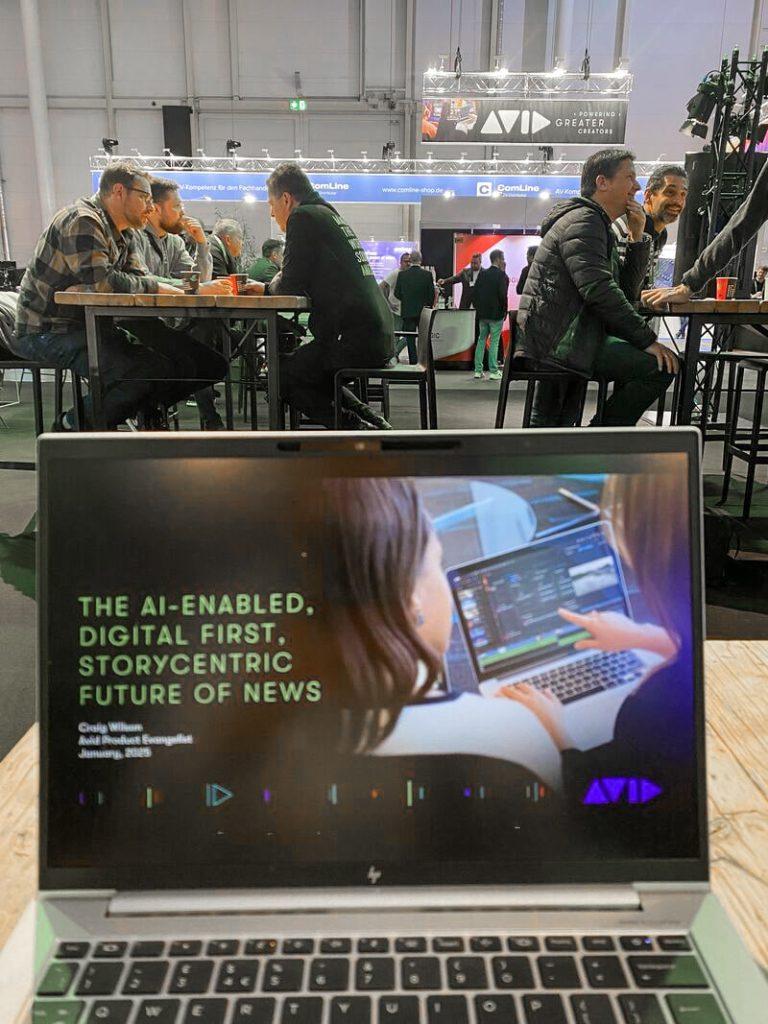American journalist and writer David Carr once said, “The future of journalism depends on our ability to innovate, collaborate, and adapt to the changing needs of our audience.”
The news business, and the wider media industry, is constantly evolving. Not just the nature of journalism and the ways in which stories are told, but also in the methods in which stories are created and distributed. From the demands of regular bulletins to the needs of the nightly news show to the constant feeding of the station website, social platforms or twenty-four-hour rolling news channels all demand attention, putting increasing pressure on news teams to deliver more.
These challenges are universal within the industry today, regardless of location it would seem. And the future of journalism and the technology which supports it was the focus of a recent presentation by Avid Product Evangelist Craig Wilson at the Hamburg Open Trade show in Germany.


An industry veteran with more than thirty-five years in the news industry, Wilson began his presentation, “The AI-Enabled, Digital-First, Story-Centric Future of News,” by setting out the technological challenges which the news industry faces in delivering to sophisticated audiences who want news when it is convenient for them on whatever platform they choose.
✓ Inefficient processes & workflows can lead to staff frustration, duplication of effort in newsgathering, manual work rather than a creative flow, a struggle to meet the demands of a modern multi-platform newsroom operation and forcing teams to use multiple tools to get the job done.
✓ Disconnected remote teams who don’t have the right tools available in the field can lead to staff using their own methods and siloed workflows to get the job done, presenting security risk and causing duplication of effort.
✓ Digital disruption is putting pressure on traditional broadcast media, leading to declining audience share, particularly among young people, falling reach, and revenue pressure as advertisers seek digital eyeballs away from linear TV.
✓ Legacy infrastructure and older equipment can hold back the pace of change and can be a security minefield, with expensive floorspace, cooling and general power consumption needed to support on-premises deployments.
Wilson offered solutions that combine media collaboration and production capabilities with story-centric planning and publishing that enable newsrooms to:
✓ Align processes and workflows
✓ Connect remote teams
✓ Deliver to more platforms
✓ Modernize infrastructure
Avid MediaCentral and Wolftech News will deliver on this vision. Wilson outlined the benefits that addressing these needs can bring to customers.
“More stories to more platforms: The delivery of an efficient workflow can seriously up the output, and also make that output of a higher quality, building trust with the audience,” Wilson explained. “Maximum creativity: By taking advantage of newer technologies, such as AI, this can free up staff to focus on creative tasks, not only making the output better, but also giving them a more fulfilling experience of work.”


He highlighted other benefits which this approach can bring such as larger audiences and engagement.
“The more high-quality content you produce, the better the chance to enhance commercial opportunities through higher audience engagement,” Wilson said. “For public service broadcasters, this can increase their reach to audiences on platforms away from traditional broadcast.”
Efficient resourcing is also key. By planning better, and using technology to gain business insights, departments, and the business overall, can work more efficiently. Eliminating duplication of effort can also free up staff to cover more events than before.
Wilson emphasized the importance of secure and cloud enabled infrastructure.
“We know that security is a major concern for customers, so by modernizing their infrastructure to take advantage of more up-to-date security implementations, they can protect their IP and ensure business continuity, along with the option to move to the cloud when it is right for them to do so,” Wilson said.
The combination of Avid and Wolftech, an Avid brand, brings all of these requirements much closer to being realized, with plans underway to deliver an end-to-end, story-centric, AI-enabled, digital-first workflow experience.


Wilson used the phrase “a single pane of glass” to highlight the approach Avid is taking to solving the challenge. By combining MediaCentral | Cloud UX and Wolftech News in a single, web-based application, along with an extremely powerful mobile app, securely accessible from anywhere, news teams will not only be better connected but also able to collaborate more effectively and deliver more tailored stories, more efficiently to audiences.


The responsible use of AI through what is known as Avid Ada is part of this approach. Avid Ada is a framework on which Avid is building AI solutions such as transcription, summarization and translation to empower journalists. Using a so-called “co-pilot” concept, Wilson said that AI is supportive of news teams.
“What journalists need to ask themselves is not whether AI is going to take their jobs, Wilson commented “It is how they can do their job more effectively by harnessing what AI can offer them.”
While the times for news organizations are challenging, they are also exciting, with more platforms offering more potential opportunities to attract audiences. The combination of Avid and Wolftech builds on that excitement, delivering new workflows, more efficiency, AI-powered capabilities and an enhanced creative environment for the future of journalism.
